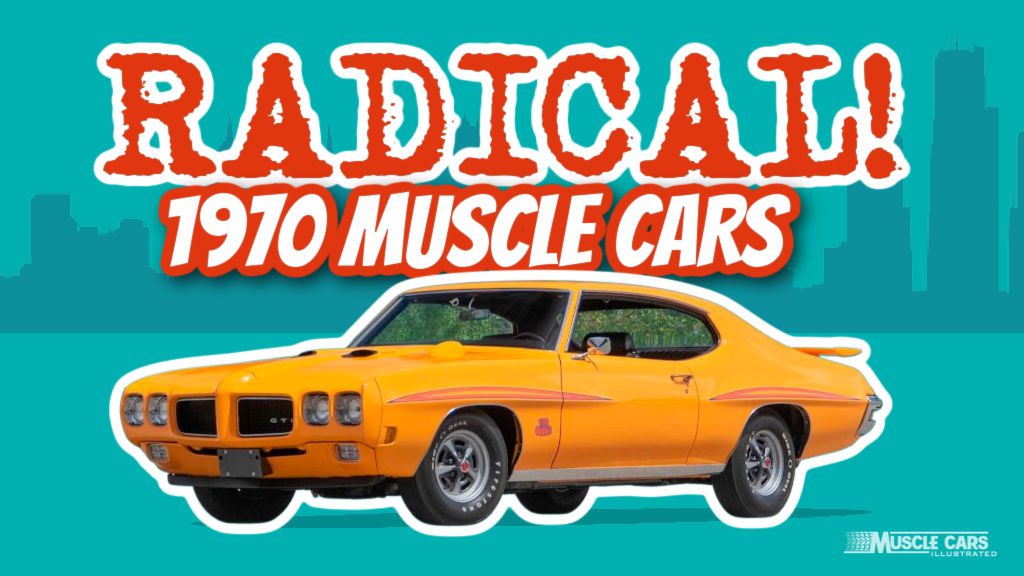
1970 muscle cars are arguably the most radical vehicles ever produced during the muscle car era. Never before were there so many cubic inches, vibrant paint colors, ram air systems, spoilers, hood stripes, and hood scoops to choose from.
General Motors lifted its 400 cubic inch limit on intermediate models, unleashing the 454 at Chevrolet and the 455 at Buick, Oldsmobile, and Pontiac. However, Chrysler and Ford had been making vehicles with 400+ cubic inches for years.
As cubic inches escalated, so did horsepower ratings. For the first time in history, a 450 horsepower LS6 454 CID V-8 engine was available in either a Chevelle SS or El Camino SS—which was 25 more horsepower than the second-place 426 Hemi produced by Chrysler.
While cubic inches and horsepower escalated to peak heights in 1970, unfortunately, like all good things, it wasn’t meant to last. 1970 was the last year for unrestrained performance before things started to get detuned.
In 1970, Congress passed the first Clean Air Act, which required a 90% reduction in emissions from new vehicles by 1975, meaning auto manufacturers would step their way towards greater efficiency one year at a time.
As a result, auto manufacturers were required to build lower compression ratio engines as part of newly adopted Federal emission standards, which started to take effect in 1971.
However, these new EPA regulations didn’t stop Detroit from building the most radical muscle cars possible in 1970, with 1971 muscle cars being another story for another article.
Let’s look at the most radical 1970 muscle cars, shall we?
Table of Contents
What Are the Most Radical 1970 Muscle Cars?
For the purposes of this article, radical is defined as the combination of high-performance drivetrains coupled with bold appearance packages. Here are the best supercars that combine ultimate performance and styling into one radical package.
1970 Plymouth Cuda Hemi
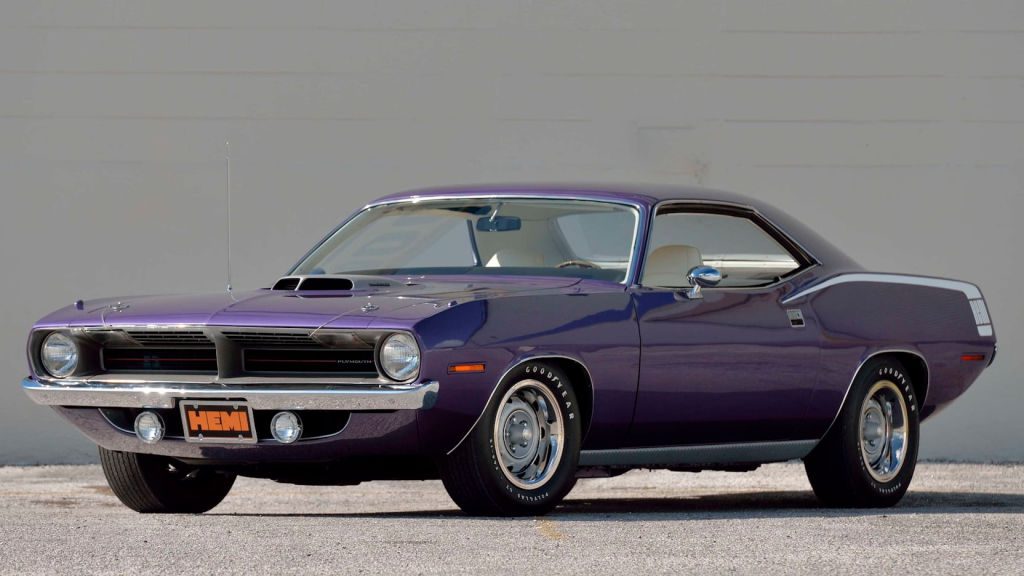
The 1970 Plymouth Hemi ‘Cuda was the fastest muscle car in 1970 thanks to a redesign that devised greater engine bay capacity in the E-Body for monstrous engines like the dual-quad fed 426 Hemi engine.
The base model was called the Barracuda. However, the Plymouth Cuda nickname was given to it by customers, and the name became the official sport model in 1970.
One step above it was the Hemi ‘Cuda, arguably the most radical muscle car in 1970. The ‘Cuda came painted in various colors ranging from subdued earth tones to high-impact vibrant color spectrums.
Optional styling features included a hockey stripe decal with engine callout, colored bumpers, Rallye gauges, hood pins, Go-Wing, and Shaker Hood, to name a few.
The standard engine was the 383 CID V-8 with 335 horsepower. Options included a 340 4-barrel (275 horsepower), 340 6-barrel in the AAR ‘Cuda (290 horsepower), 440 4-barrel Super Commando (375 horsepower), 440 6-Barrel Super Commando (390 horsepower), and a 426 8-barrel Hemi (425 horsepower).
In the November 1969 issue of Car Craft magazine, a 70 Hemi ‘Cuda did a standing quarter-mile in 13.10 seconds at 107.1 miles per hour. Plymouth produced 652 Hemi coupes and only 14 Hemi convertibles in 1970.
1970 Chevelle SS 454 LS6
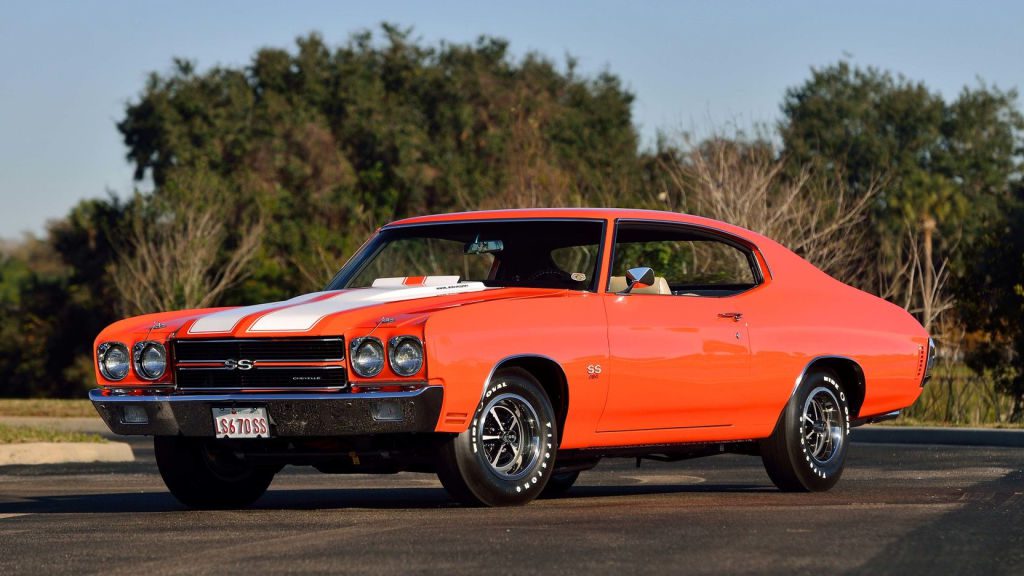
The 70 Chevelle SS featured four engine options, including two “396” (actually a 402 CID V-8) CID V-8s and two 454 CID V-8s—the highest performance option being the LS6 SS454.
The LS6 is Detroit’s most powerful and radical muscle car ever released during the muscle car era, featuring 450 horsepower @ 5600 rpm and 500 lb-ft of torque. Buyers had the choice of either a Muncie 4-speed manual or a 3-speed Turbo Hydramatic automatic transmission.
In terms of performance, an LS6 Chevelle SS454 could run 13.12 seconds in the quarter-mile, traveling 107 miles per hour with 0-60 times of 5.4 seconds.
Both the SS396 and SS454 packages included “SS” badging, a domed hood, blacked-out grille, power disc brakes, dual exhaust, 5-spoke sport wheels, Firestone Wide Oval white lettered tires, chrome wheel opening moldings, black resilient rear bumper guard, bright engine accents, 12 bolt rear end, and special suspension enhancements.
However, contrary to popular belief, hood and decklid stripes, hood pins, and Cowl Induction were not standard on all 1970 Super Sport Chevelles. As shown above in special ordered Hugger Orange—a 1969 paint color attributed to the Chevrolet Camaro.
1970 Plymouth Superbird 426 Hemi
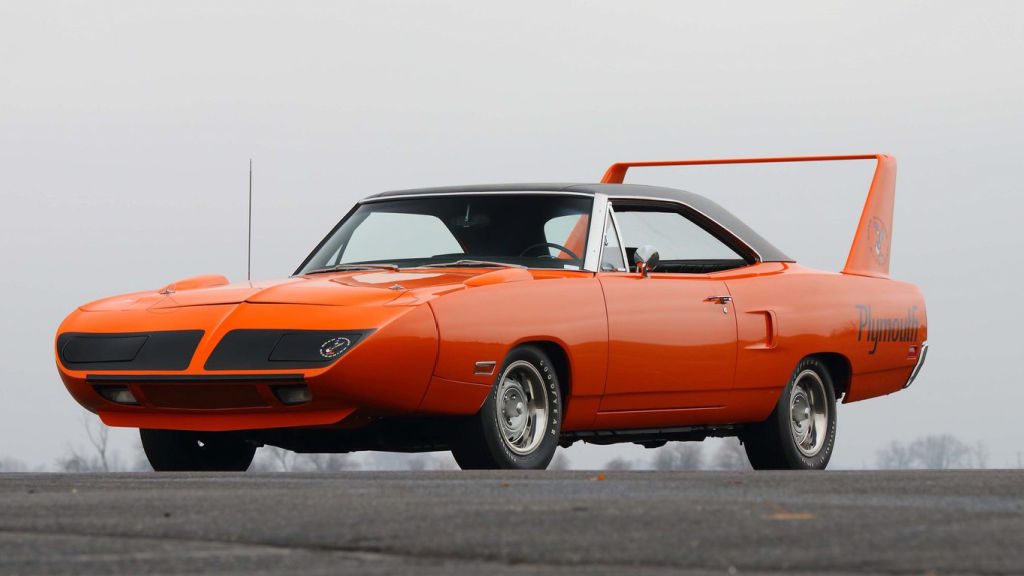
The Plymouth Superbird was Plymouth’s way of courting Richard Petty back as its top NASCAR racecar driver, who left to race for Ford in the 1969 racing season after the disappointing performance of the brick that is a 1968 Belvedere.
And it worked.
Petty won 18 races with 31 top-10 finishes in the 1970 NASCAR season.
The 70 Superbird came standard with a 440 CID V-8 rated at 375 horsepower @ 4000 rpm with 480 lb-ft of torque. Optional was the 440 6-bbl rated at 390 horsepower @ 4700 with 490 lb-ft of torque and the mighty dual quad 426 Hemi rated at 425 horsepower @ 5000 rpm with 490 lb-ft of torque.
Also standard was the 4-speed manual transmission with Hurst shifter, and the optional 3-speed TorqueFlite automatic transmission was also standard.
The best quarter-mile time recorded was 14.26 seconds at 103.7 miles per hour with a 0-60 time of 5.9 seconds.
The Superbird began life as a base 1970 Belvedere, having the front clip removed and replaced with a set of Coronet front fenders with “vents” above each wheel to help with wheel clearance.
Next, assembly workers added a graphic package, tapered nose cone, front chin spoiler, and a customized Coronet hood.
Lastly, workers modified the rear window panel for greater aerodynamics and bolted a 20 inch rear spoiler to the rear decklid. All 1,935 came standard with a black vinyl top, regardless of paint color.
1970 Buick GSX Stage 1 455
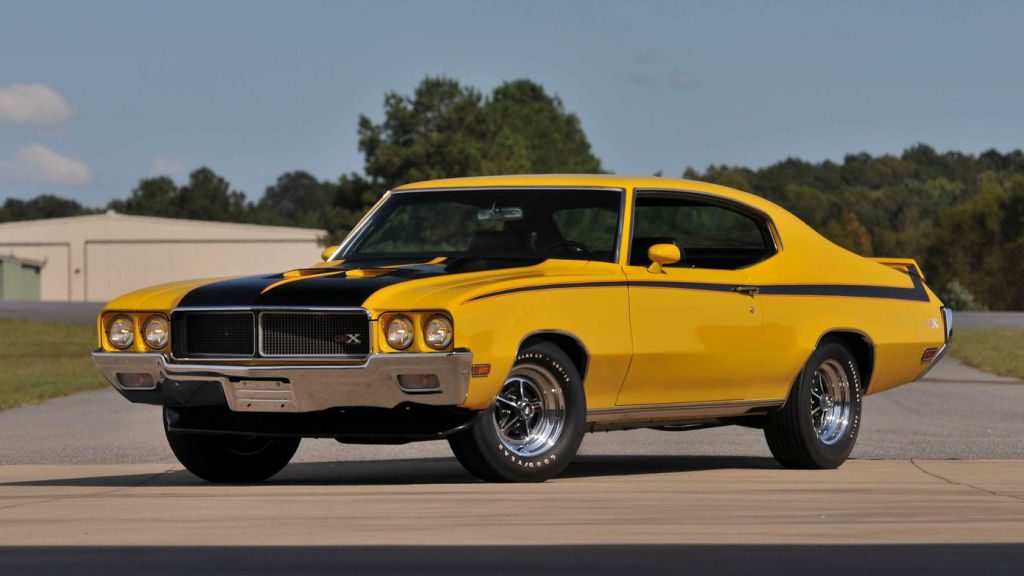
The Buick GS was a gentleman’s muscle car built for luxury first and performance second. However, that all changed when Buick added the out-of-this-world 455-powered GSX in 1970.
The Buick GSX came standard with a 455 CID V-8 with 350 horsepower @ 4600 rpm with 510 lb-ft of torque @ 2800 rpm.
Optional was the impressive Stage 1 455, rated at 360 horsepower @ 460 rpm with 510 lb-ft of torque.
The standard transmission was the 3-speed manual with optional 4-speed manual and 3-speed automatic transmissions.
The 1970 Buick GSX Stage 1 recorded 0-60 times of 6.9 seconds with a standing quarter-mile time of 13.7 seconds traveling at 101.2 miles per hour. While the GSX version ran a 13.66 ET at 100.2 MPH.
In addition, the GSX appearance package added choice upgrades, including:
- GSX emblems and decals
- Front spoiler
- Rear spoiler
- Black matte hood stripes with red pinstriping
- Black bodyside/rear spoiler striping with red pinstriping
- Color-keyed Sport Mirrors
- Color-keyed headlight bezels
- Hood tach
- 5-Spoke chrome wheels
- Super Wide Oval White Billboard Lettered Tires
- Full-length console
- Padded steering wheel
- Black bucket seat interior
- Rallye steering wheel
Interestingly, the GSX was available in only two colors, including Saturn Yellow and Apollo White, with a mandatory black bucket seat interior in each.
Buick made 678 GSXs in 1970, with 479 having the 455 Stage 1 and 199 with the standard 455.
1970 Pontiac GTO Judge Ram Air IV
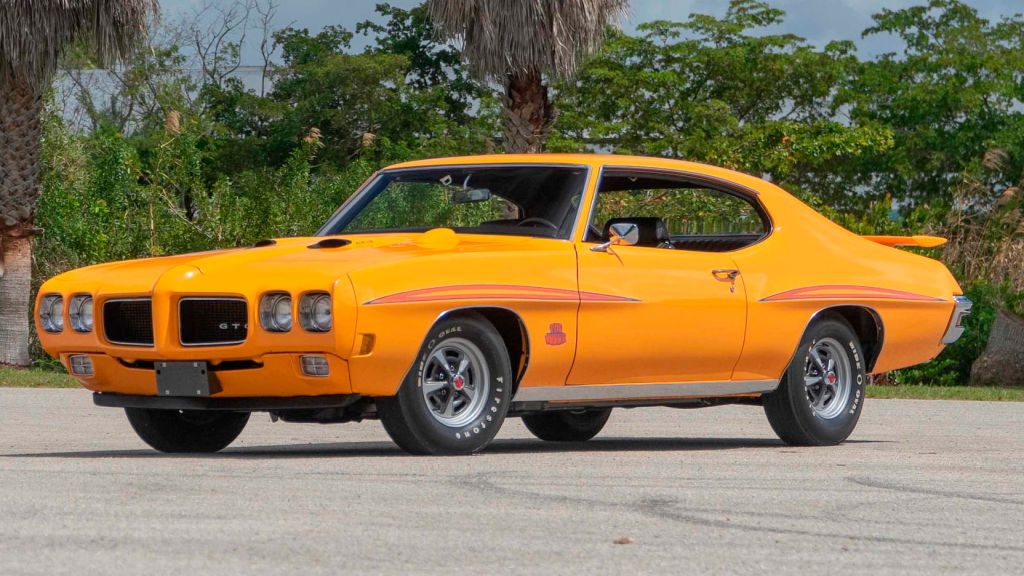
The Pontiac GTO Judge was the most radical appearance package available of all GTOs, coming standard with a D-Port Ram Air III 400 CID V-8 rated at 366 horsepower @ 4000 rpm with 445 lb-ft of torque.
The oval port Ram Air IV 400 CID V-8 was optional, producing a grossly underrated 370 horsepower @ 5500 rpm with 445 lb-ft of torque.
The Ram Air IV GTO Judge was no slouch, with 0-60 times of 6.2 seconds and a quarter-mile time of 13.60 seconds, traveling 104.5 miles per hour, according to
A 3-speed manual was the base transmission, with an optional 4-speed manual and 3-speed automatic also available.
The Judge package included four multi-colored eyebrow stripes over each wheel, Rally II wheels sans trim rings, rear deck spoiler, and Judge graphics on the front fenders and rear decklid. An optional dash-mounted hood tach was also available.
A knob controlled the Ram Air induction under the driver’s side dash, and once pulled, would open up the flaps inside each hood scoop using vacuum pressure.
Pontiac produced 3,797 GTO Judges in 1970, with 3,629 hardtops and 168 convertibles.
1970 Ford Mustang Boss 429
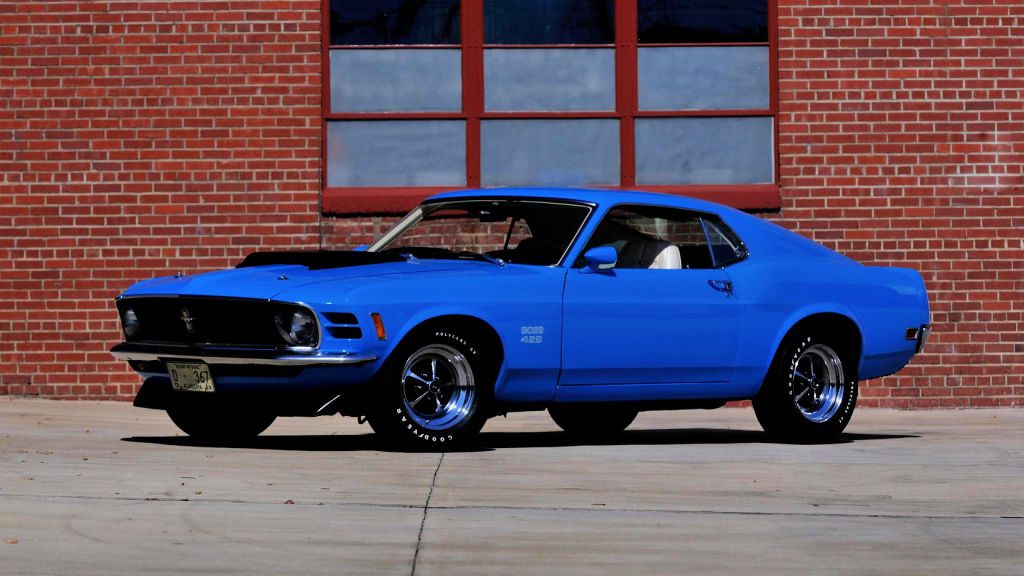
There were no shortages of 1970 Ford Mustang models to choose from, including the base, Mach 1, GT, Shelby, Boss 302, and Boss 429 options.
Arguably, the penultimate high-performance Mustang was the Boss 429, made specifically to homologate the Semi-Hemi 429 engine—not the Mustang itself—for NASCAR racing.
The 1970 model year was the second and final year for the ballistic Boss 429 Mustang. The Boss 429 semi-hemispherical engine featured a 4.00 x 3.50 bore and stroke, 10.5:1 compression, 375 horsepower @ 5,200 rpm, and 450 lb-ft @ 3,400 rpm.
However, the compact Mustang engine compartment needed extensive modification to stuff the 429 between its fenders, so Ford sent them all to Kar Fraft for conversion.
Kar Kraft widened the shock towers and relocated the front suspension and motor mounts to fit it all. Ford only produced a total of 499 Boss 429s in 1970.
1970 Dodge Super Bee 440 Six Pack
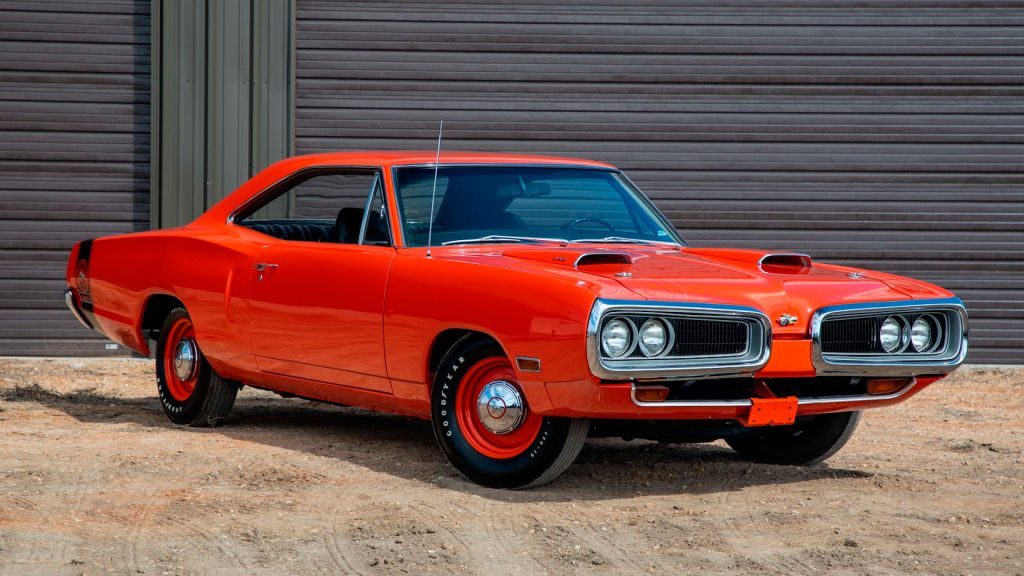
Dodge redesigned the 1970 Super Bee with a distinguishing front bumper resembling “bumblebee wings,” a unique “C” shaped decal with the Super Bee logo on both rear quarter panels, and a distinctive dual-snorkel hood.
The 1970 model year also introduced high-back bucket seats, ignition on the column, and a Pistol Grip shifter when a customer opted for the 4-speed manual transmission.
Engine choices carried over from the 1969 model year, including the standard 383 CID V-8 rated at 335 horsepower @ 5,200 rpm with 425 lb-ft of torque.
Optional was the 440 “Six Pack” (3 x 2bbl carburetors) rated at 390 horsepower @ 4,700 rpm with 490 lb-ft of torque @ 3,200, and the 426 Hemi rated at 425 horsepower @ 5,000 rpm with 490 lb-ft of torque @ 4,000 rpm.
A 440 Six Pack powered Super Bee could run a quarter-mile in 13.80 seconds traveling 102.0 miles per hour. Dodge produced 14,139 Super Bees in 1970, with 196 coupes and 1,072 hardtops receiving the 440 Six Pack.
1970 Oldsmobile 4-4-2 W-30
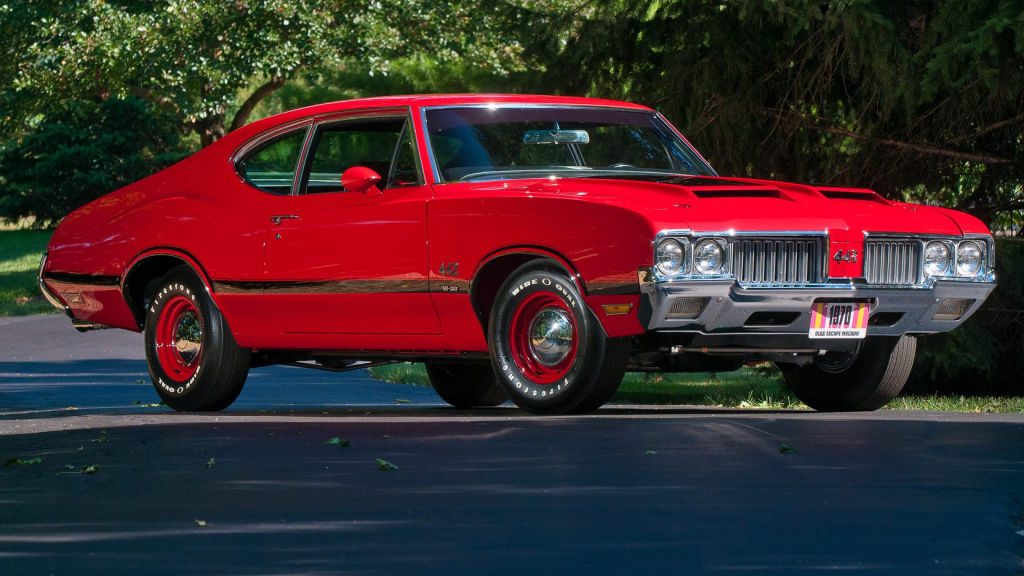
The Oldsmobile 4-4-2 reached its zenith of performance and styling in 1970. Oldsmobile meant business in the performance department, making a 455 CID V-8 with 365 horsepower and 500 lb-ft of torque the standard engine in the 4-4-2.
However, the W-30 peak powerhouse performance 455 engine offered 370 horsepower @ 5,200 rpm with 500 lb-ft of torque @ 3,600 rpm.
In addition, the W-30 package added a W-25 fiberglass hood with twin functional ram air scoops, low restriction air cleaner, W-30 badging on the front fenders, body side stripes, aluminum intake, and special camshaft, heads, distributor, and carburetor.
The standard transmission in the 4-4-2 was the Heavy Duty 3-speed manual, with options including a 4-speed manual or 3-speed TurboHydramatic automatic. However, Oldsmobile mandated the 4-speed in the W-30, with the TH400 automatic being optional.
In the April 1970 issue of Popular Hot Rodding, a W-30 tripped the lights at the dragstrip in 13.89 seconds at 101.1 miles per hour. In addition, the 4-4-2 was available in multiple body types, including a Sport Coupe, Holiday Hardtop, and Convertible model.
Olds produced a total of 3,100 W-30 machines that year.
1970 Ford Torino Cobra
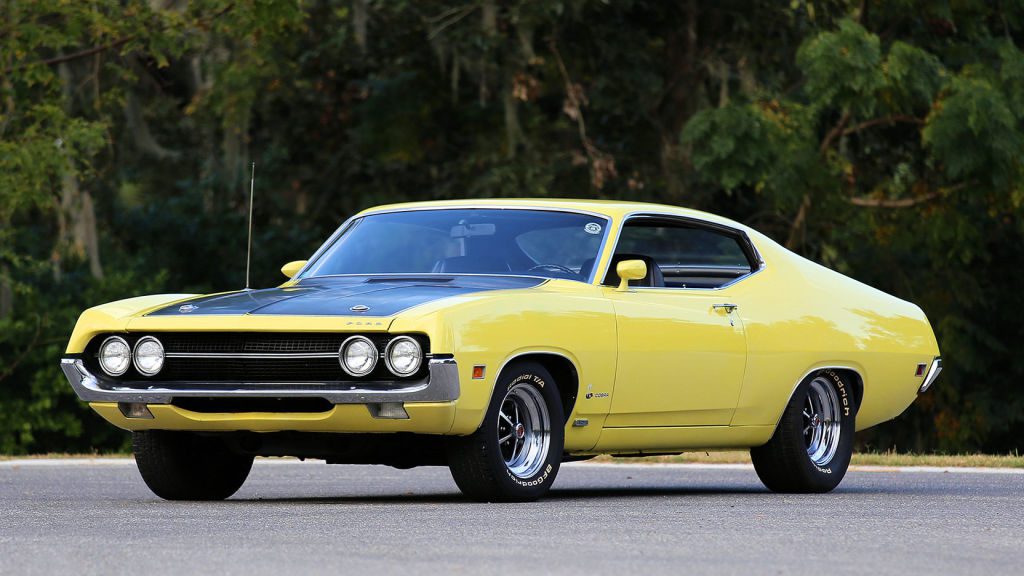
The second-generation 1970 Ford Torino Cobra packed a one-two punch with the styling of a jet aircraft and the might of a 375 horsepower 429 Super Cobra Jet—part of the Drag Pack option.
When a buyer selects the Drag Pack option, it converts a 429 Cobra Jet into a 429 Super Cobra Jet and mandates either a 3.91:1 or 4.30:1 axle ratio. Ford also upgraded the engine block to 4-bolt mains, forged pistons, solid lifter cam, 780 CFM Holley carb, and an engine oil cooler.
Ram Air was optional and included a “Shaker Hood,” where the scoop was attached to the air cleaner assembly that passed through a cutout provision in the hood.
The 4-speed manual was the standard transmission, with an optional 3-speed Cruise-O-Matic automatic for those seeking a more passive driving experience.
The Torino Cobra SCJ is extremely rare, with Ford only producing 241 on the assembly line. But, while rare, it was also a runner at the dragstrip.
In the March issue of Super Stock and Drag Illustrated, a Torino Cobra SCJ tripped the lights at the dragway in 13.63 seconds at 105.9 miles per hour.
1970 AMC Rebel Machine 390
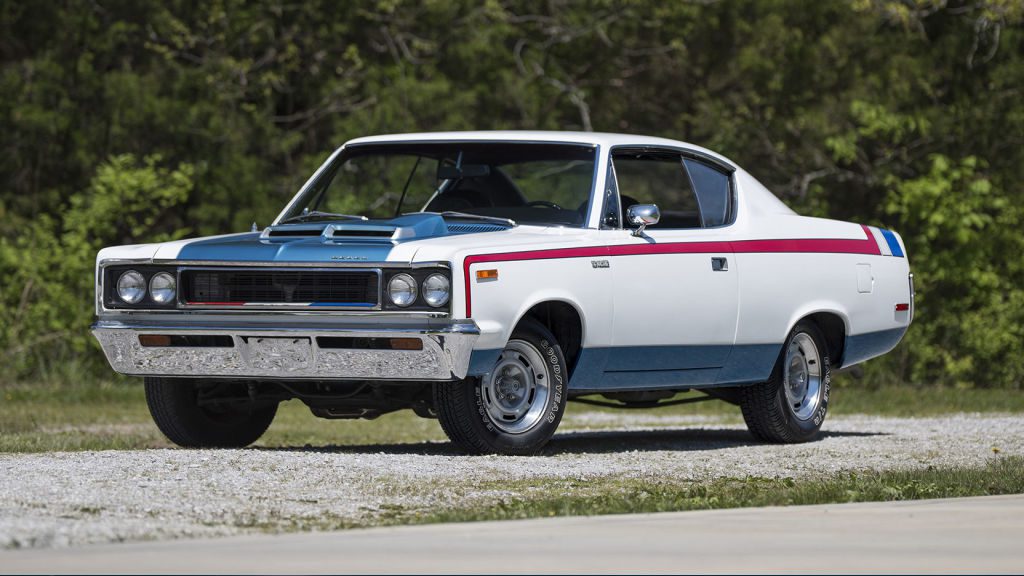
Developed by Hurst and introduced at the NHRA World Championships in Dallas in October 1969, the 1970 AMC Rebel Machine was American Motors’ spiciest performing Rebel.
The first 1,000 Rebel Machine sported a radical patriotic red, white, and blue striped paint scheme, with the remaining 1,326 sprayed in any solid standard Rebel paint color.
The Machine featured a 390 CID V-8 rated at 340 horsepower @ 5100 rpm with 430 lb-ft of torque @ 3600 rpm.
The standard transmission was the 4-speed manual Borg Warner with optional 3-speed Shift Command automatic.
In addition, the Machine package included a large “Air Box” hood scoop with an embedded tach, power disc brakes, Goodyear E60x15 Polyglas tires on 15×7 styled wheels, and a 3.54:1 limited-slip differential.
The Rebel Machine produced a 0-60 time at 6.4 seconds with a standing quarter-mile time of 14.40 seconds at 100.6 miles per hour. It was one of the most powerful AMC Muscle Cars produced.
1970 Mercury Cougar Eliminator Boss 302
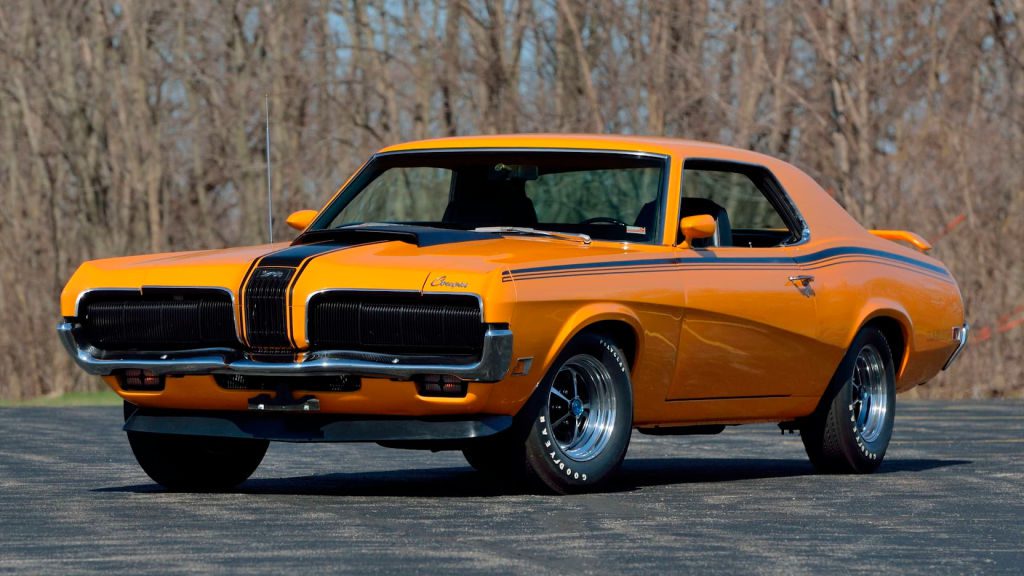
The Mercury Cougar Eliminator was the ultimate high-performance Cougar muscle car model in 1970 and featured a bold, distinctive pony car look.
Exclusively produced in Dearborn, Michigan, the Eliminator came standard with a 351 Cleveland and offered three additional options, including a Boss 302, 390, and 428 Cobra jet.
While the 428 Cobra Jet was the peak performance powerplant, the small block Boss 302 was no slouch at the track.
The Boss 302 was originally part of Ford’s homologation requirements for the SCCA Trans-Am racing series. When optioned with a Boss 302, the 4-speed manual transmission was mandatory.
In addition, a “Shaker Hood” Ram Air assembly and Super Drag Pack option were available, which included a 4.30:1 Detroit Locker rear and an engine oil cooler.
At only 450 produced, it is a rare and desirable collectible today.
Eliminators offered a performance-tuned suspension, including a rear sway bar and staggered rear shocks to help it through the corners.
They were available in six colors: Competition Orange, Competition Yellow, Competition Blue, Competition Gold, Competition Green, and Pastel Blue.
Each Eliminator had stripes on the hood and body lines, a black front chin spoiler, and a color-keyed rear decklid spoiler.
Regarding performance, a Boss 302 Cougar Eliminator ran 0-60 times of 7.6 seconds with a standing quarter-mile time of 14.40 seconds at 98 miles per hour.
Conclusion
There were over 40 different 1970 muscle cars, but they weren’t created equal. The eleven supercars featured here had distinctive looks and power unrivaled on the streets of America in their day.
Take Our Poll!
Well, there you have the most radical 1970 muscle cars. Be sure to subscribe to see more content like this!

Ryan Wheaton
Ryan has owned muscle cars since 1986 and currently owns a 1972 Dodge Charger Rallye. He combines passion and experience to create engaging content for fellow muscle car enthusiasts. In 2018, he founded Muscle Cars Illustrated, authoring hundreds of articles on tips, history, and trends in the muscle car industry. He attends national car shows, auctions, and museums to stay current with the latest developments in the muscle car industry.Comments
Comments are closed.

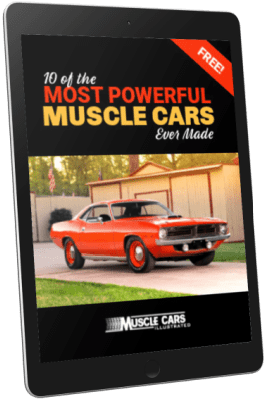
I only remember riding in one very rare AMC AMX but it was second favorite car after my custom ’70 Chevelle SS 396. We use to race every Friday and Saturday night in the Great NE Philly on the famous Decatur Road. Those were the days!
I can remember it rained dawn to dusk. Saturday, April 22, 1978 and I was waiting at Hinkley Dodge (Salt Lake City) for someone to show up so I could buy that car before someone else did. It sat in the lot behind the service bays, but you could catch a glimpse of it from the street. How could you not see that glorious purple glow. A 1970 Super Bee packin’ all the goodies on my wish list; high impact paint, 440 six-pack, 4-speed, Ramcharger hood, and a price I could afford. A buddy had spotted it while picking up parts for his older brothers car. Finally, at 7:22 am, the new-car sales manager showed up. By 8 that morning it was official. I was the soaking wet owner of a 78,000 mile car with a fuel leak, bad battery, and bald rear tires, but for $1,522 that beast was mine and there wasn’t a damn thing dad could do to change that. I’ll never forget that soggy, super Saturday in Salt Lake when I got my first car. What a car.
1970 Nova SS 396/375. It was really a 402. This L78 got new heads fir 1970. Semi open chamber. 110cc instead of 105. Also had the 1.88” exhaust valve which really boosted horsepower. You could get a 4 speed or auto. I generally am a stick guy, but that turbo 400 that year was special. Variable stall, switch pitch – it was sneaky fast. 3:73 12 bolt posi and D70x14s. Smoke em till you blow the tires.
LS7 Corvette. They didn’t sell the car, but a trip to the parts counter and all the parts were there if you had the coin. It was a be monster . A friend of mine built a black/black 4 speed. The car was scary fast. It was like the L88 but was a 454. He put a set of tires that hooked up. Rear end blew the first week. With good tuned headers it was close to 600hp